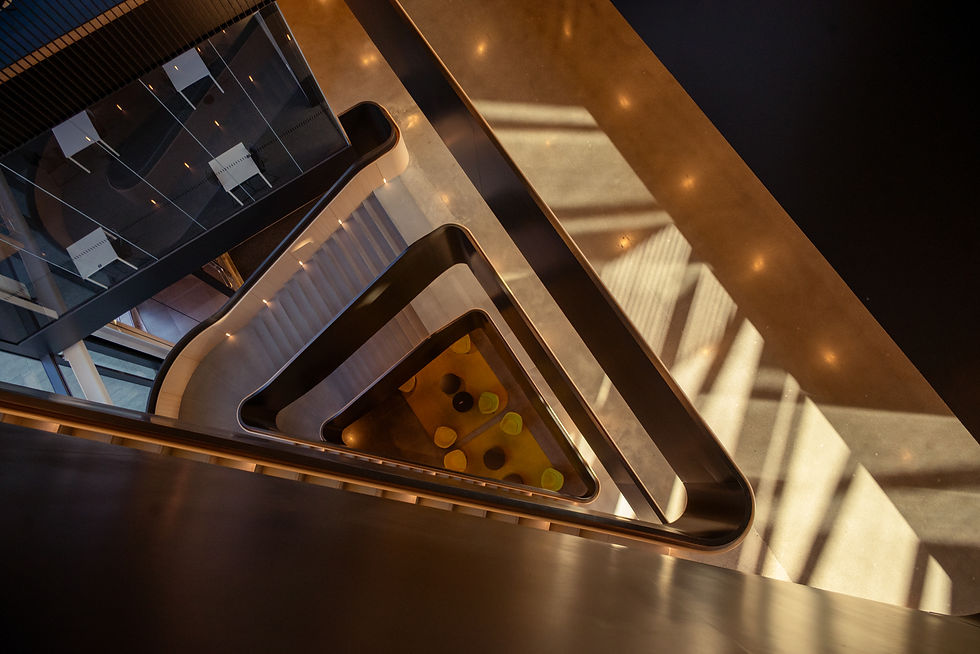Architecture You’ve Never Noticed
- Mayzie Wusz
- 15 hours ago
- 3 min read
How BU’s campus is designed for you
By: Mayzie Wusz

Every day, students at Boston University climb stairs, push through heavy glass doors and walk across sunlit plazas, unaware that each of those movements were carefully designed for them. Despite being so influential, many forget that the height of a step, the angle of a bench, the warmth of a door handle were not made by accident, and that architecture is really about what we feel as we navigate spaces. The small details of the built world substantially shape our pace, posture and how we connect with others.
Step by Step
You might not think twice about the rhythm of your steps running up the stairs of CAS, but that rhythm is guided by science and precision. Most modern staircases follow a rule known as the “Stair Formula”: two times the riser height plus the tread depth should equal 24”-25” inches. The familiar seven-inch rise and 11-inch tread found across BU’s campus is not random, but rather the perfect proportion for an average stride. Maintaining uniform stair dimensions is critical for safety, with even a small change in riser or tread depth disrupting stride and becoming a safety hazard. Maybe just as importantly, comfort is impacted as well. Too steep, and you feel rushed or off-balance, and too shallow, your steps feel uncomfortable (for example, notice the steps to the second floor of CDS!).
First Impression
Juhani Pallasmaa, a Finnish architect and theorist, described in his book “The Eyes of the Skin” that all perception is an extension of touch. You can feel this idea in the simple act of grabbing a door handle. A cool, heavy metal handle gives a different first impression than a worn brass one. You could consider it the “handshake” of a building, which can inform you a lot of who you are about to meet. At the CAS building, you are greeted with doors that are weighted, metal and old, which gives me an academic and historic impression. These smallest interactions affect how we relate to architecture, often before we have even stepped inside.
Design as Freedom
William H. Whyte, who studied how people behave in urban settings, discovered that social life thrives in spaces that offer both movement and choice. He observed that people often stop and chat directly in the busiest pedestrian flows rather than moving aside — something you probably notice in the packed hallways between classes. Circulation and congregation go hand in hand.
On BU’s campus, places like the GSU plaza and the BU Beach work because they provide options: shade or sun, solitude or company, sitting or standing. These are spaces that adapt to students rather than forcing students to adapt to them. Choice creates comfort, and comfort reinforces community.
Shaping a Space
Architecture does not stand still. Stewart Brand, author of “How Buildings Learn,” describes buildings made up of layers that change at different rates — structure, skin, services, space plan and “stuff.” The stuff of BU’s buildings — the desks, boards, seats — change as classes shift and students adapt. But the structure, the bones of the campus, evolve slowly. Many of BU’s spaces belong to what Brand calls “low road”. These are buildings which are flexible, slightly messy spaces that allow for creativity and change.
Jan Gehl, an urban designer, calls this quality “livability.” It is the idea that cities, and by extension campuses, should make it easy for people to live a full life. When a plaza invites you to linger or a hallway encourages you to slow down and talk, the designs add up to something larger. They shape how you experience your education, your community and your sense of belonging.
So when you next cross the BU Bridge or sit on a bench outside Mugar Library, notice how the step beneath your foot feels natural or how the bench is oriented for your comfort. Once you begin paying attention to these quiet details and considering why they were made, the campus around you might gain another meaning. There is an articulate system of design decisions that tells you how to move, when to pause and where to gather, bringing us together in subtle and important ways.
Comments